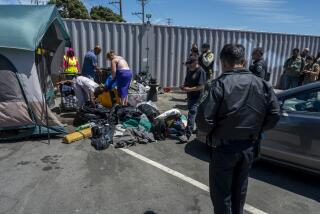Self-Help for Homeless Is a New Tactic
- Share via
Paul Wood remembers the incident that pushed his simmering discontent over not having a permanent address into a boiling anger.
It was 3 in the morning in a Ralph’s supermarket parking lot in Garden Grove. Wood, his wife and three children had been living in their camper for more than a year. Tired of being hassled by police in the local park, the Woods and a small band of homeless acquaintances had struck an agreement with the store’s management: In return for keeping the lot clean, they could park overnight for free. But despite the agreement, police put flyers on windshields citing a city ordinance against living in cars.
Then in the middle of the night, someone banged loud and hard on Wood’s camper door. Wood’s bleary-eyed wife answered it. She was met by a police officer.
“You get your (expletive) ass out of here and out of Garden Grove and don’t come back,” Wood remembers the police officer yelling at his wife.
“No damn respect,” Wood snorts in his sandpaper voice, puffing on a cigarette.
His anger today, however, is tempered by a measure of self-content. As executive director of the Homeless Action Project, Wood, 47, advises other homeless people who have experienced similar treatment on how to fill out police-abuse forms and file them with the county’s Human Relations Commission. He also teaches homeless people how to collect Social Security or welfare, how to write a resume and find a job--or, if they are already working, how to find a better-paying job--and where to get emergency shelter, food and medical or dental care.
The Homeless Action Project, which survives mostly on donations, recently was awarded a $9,000 grant through United Way.
Homeless doesn’t necessarily mean helpless, Wood has discovered. “We teach the homeless to help themselves,” he said. It is a message that he delivers, along with food, blankets and information, to the homeless people he visits twice daily in Garden Grove Park or who come to his small, crowded office in a one-story cluster of suites at 9776 Katella Ave. in Garden Grove.
Wood is not alone in thinking that no one takes care of “you” better than yourself. Several homeless shelters in Orange County have based their programs on the philosophy that being responsible is a solid step in countering the most insidious afflictions affecting the homeless: depression and lack of self-respect.
Christian Temporary Housing is the oldest family shelter in Orange County. The organization accepts only families with children, who can stay up to 60 days. The families help run the shelter--one full-time director is a former homeless person--and are required to do their own cooking and cleaning. They also are required to save about 80% of their income--from jobs the shelter helps them find or from government checks--so that they can begin to survive on their own. The shelter also tries to help them find permanent housing.
The shelter was started 11 years ago by Mike Elias, who came to Costa Mesa from Maryland, a single father with his two young sons, on the promise of a job and housing. Neither materialized. Elias and his children lived in their car for a while before going to Christian Temporary Housing, which at that time was about to fold. Elias agreed to take over management and over the years developed the program that exists today. He eventually raised enough money from donations and government grants to buy a house. Today, Christian Temporary Housing runs shelters in Tustin and Orange. In November, Elias moved to Norwalk to start a new shelter.
When Elias found himself homeless for the first time in his life, he discovered that shelters in Orange County were almost nonexistent. And those that did provide help also separated families, simply provided handouts or subjected people to a religious message, whether they wanted to hear it or not.
“It really angered me,” Elias said. “A box of food? What do you do with a box of food when you’re living in your car” and have no place to cook it?
Elias vowed to supply dignity along with food and shelter in the program he developed. He is a strong believer in programs that require the able-bodied and sound of mind among the homeless--excluding children, battered children or runaways--to help themselves. He noted, however, that his is not a popular view among homeless advocates who think the government should take more of the blame.
“(The thinking) that everything is just a handout has got to stop,” Elias said. “It takes a lifetime to get ahead,” which doesn’t stop at simply getting a job. “Our people are doing that. They’re not just sitting around waiting for a meal.”
Laurie Smith, a social worker who took over as head of the Orange shelter when Elias moved to Norwalk, said the homeless carry around with their physical belongings a lot of emotional baggage: depression and a sense of helplessness, frustration and a feeling of having no power. She thinks those emotions are heightened in Orange County, where “you’re sitting right next to someone (on the freeway) driving a Mercedes around.
“Giving (the homeless) responsibility motivates them and makes them feel better about being there” and receiving help, she said.
The Orange Coast Interfaith Shelter, a 9-unit apartment complex in Costa Mesa that houses up to 80 people a night, also is structured so that people staying there take part in running the haven. They help distribute food, clean and do the gardening, among other chores. The resident manager is the father of 5 children; they were homeless when they came to the shelter 5 years ago.
Taking part in running the shelter is “a nice way for them to give back” some of the help the families receive, director Cindy Ochs said.
Scott Mather is an insurance salesman by vocation, but he has been a homeless advocate by avocation for almost a decade. He is chairman of a number of organizations founded to help the homeless, including the Orange County Homeless Issues Task Force.
Getting the homeless to assist in their own rescue is one thing, but harnessing their anger and frustration to make the system work better for them, as Wood of Homeless Action is trying to do, is another thing, Mather believes.
“My experience has been that there’s not a lot of success at it,” he said.
The homeless population tends to be transient, and most of them are so busy trying to take care of daily needs that they don’t have the energy or time to take on bureaucracies as well, Mather said.
And their numbers in Orange County are growing at an alarming rate, Mather noted. He bases that belief on statistics kept over the past 4 years by Share Our Selves, a nonprofit Costa Mesa group that provides emergency food and shelter. Mather is chairman of the SOS board.
In 1984, SOS started keeping tabs on the number of homeless who were receiving some kind of assistance in the month of October. In 1984, 15,000 people, 750 of whom were homeless, received aid during that month. In October, 1988, SOS provided aid to 19,000 people, 4,500 of whom were homeless. The number of homeless receiving aid in October soared 500% during that 4-year period, while the total number served increased 27%.
“Homelessness (in Orange County) is just going through the roof,” Mather said.
Using an assortment of desktop computers, Paul Wood of Homeless Action also keeps track of the homeless who have come through his office door. But Wood likes to cite the successes.
From June 20 through Sept. 30, Wood figures he has served 832 people, 337 of whom were children. He estimates that he has helped 18% receive some sort of welfare, Social Security or other benefit, and with his assistance, 24% found work.
But Wood admits that many people vanish after he has seen them. And some, known as “shelter hoppers,” he sees too often.
Not long ago, Wood was, in some respects, not any different from the growing number of homeless in Orange County who have found themselves priced out of the housing market.
Wood had rented a house for 8 years in Garden Grove with his wife and six children before he had a stroke in 1983 and was laid up for more than a year from his job as a cement contractor. Wood wasn’t able to return to work and the disability payments and family savings dwindled. Then about 3 years ago, Wood’s landlord sold the house and gave the family 30 days’ notice. Wood and his wife decided to use what would have been a month’s rent to buy a camper, figuring they could save enough in a couple of months to rent another house.
But rents kept escalating. Two months turned into 6, then 12. Wood wanted to keep the three youngest children still living with him in the same Garden Grove schools, so he set up a sort of camp, along with other homeless people, in Garden Grove Park.
Wood said he and others were harassed by Garden Grove police. City Hall was no help, Wood claimed. The local government refused to acknowledge that the community had a homeless problem, he said.
Wood eventually joined forces with Jim Miller, who ran a project called Shelter for the Homeless in Westminster and Midway City. With Miller’s aid, Wood and a band of other homeless people from Garden Grove Park pooled their money to rent a dilapidated building in Westminster where they could park their campers without being hassled. They refurbished the building to use as a home base and also as a place to administer a food-distribution program called Food Bargains.
Wood’s group bought groceries from the Orange County Community Development Council and Grocery Warehouse, then repackaged them and sold them “to anyone who walked through the door” for a bit more than cost, making about $1 profit on each bag. If people couldn’t afford to pay, they weren’t charged. At the same time, Wood helped Miller run his shelter program.
But Wood and Miller disagreed over how the shelter program was being run and they split. Then Wood formed the Homeless Action Project, which held its first meeting in May, 1987, in a Lutheran Church in Garden Grove. The second was held in the Fair Housing Council of Orange County offices in Santa Ana. The group incorporated 2 months later. Half of the 16 members of the board are homeless or formerly homeless people, Wood said. Members also include representatives from the Fair Housing Council, YWCA and Veterans Administration.
The project has given Wood a new direction in his life--he is out of the camper, renting a home in Garden Grove and living, for the time being, on a one-time stipend he received for helping administer distribution of a $138,000 federal grant to provide aid for the homeless in Orange County. He doesn’t draw a salary from his work for the Homeless Action Project.
Wood has learned a lot about getting the system to work for him instead of being a helpless victim, and he has tried to teach that to other homeless people. But he has also discovered that “you can’t help someone who won’t help themselves.” He concluded:
“There’s some people who, no matter what you do for them, are not going to help themselves.”
More to Read
Sign up for Essential California
The most important California stories and recommendations in your inbox every morning.
You may occasionally receive promotional content from the Los Angeles Times.










